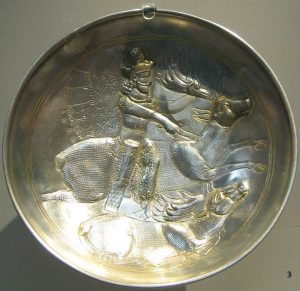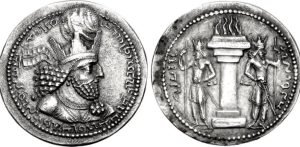In an attempt to create a ranking order, our Gemara gives an interesting royal analogy:
“King Shapur and the Roman emperor. Rav Pappa said to Rava: Which of them is greater? Rava said to him: Does he eat in the forest? Go out and see whose coin circulates throughout the world,” (Shevuot 6b)
Besides learning the way the rabbis asked “do you live under a rock?” this story raises interesting questions about who the rulers were in the times of the Amoraim. Shapur (or Shevor Malka as he is called in the Gemara) is a Sasanian king, ruling in Babylonia. The Caesar is of course the Roman emperor, whose vast empire includes the Land of Israel. Which one is stronger and how are the rabbis connected to them?
While our Gemara does not name a specific Roman emperor, it does give us the name of Shapur, the king in Babylonia. But even this is unclear. There are two Shapurs mentioned in Rabbinic sources. Shapur I ruled from 241 – 272 CE and was a contemporary of Rav and Shmuel. Shapur II ruled from his infancy to his death, an astonishing seventy years, from 309 -379 CE. His reign corresponds to the third and fourth generations of Amoraim, including both Rabba and Rava (see here to distinguish). Both kings are part of the Sasanian dynasty which had succeeded the Parthians in the third century. They both followed the Zoroastrian religion, a religion that caused some trouble for the Jews of Babylonia.

Sasanian and Roman borders in the 4th century
User:Giorgos Tzimas, CC BY-SA 3.0 <http://creativecommons.org/licenses/by-sa/3.0/>, via Wikimedia Commons
Shapur I seems to have had a mostly good relationship with the Jews, and in particular with Shmuel, one of the greatest Jewish leaders of Babylonia. He asks Shmuel questions and banters with him:
“King Shapur of Persia said to Shmuel: You say that the Messiah will come on a donkey; I will send him the riding [barka] horse that I have. Shmuel said to him: Do you have a horse with one thousand colors [bar ḥivar gavanei]” (Sanhedrin 98a)

Shapur I on his horse
Diego Delso, delso.photo, License CC BY-SA
Shapur I had respect for the Sages and when they visited him he was careful to follow the rules of kashrut (Avoda Zara 76b). He was even known to distribute money to the poor (Bava Metzia 70b).
But the shadow of the struggle with Rome hung over Shapur I and it ultimately also affected his relationship with the Jewish community, albeit not with Shmuel. His preoccupation with the Romans is clearly noticed by Shmuel who offers him this dream:
“King Shapur said to Shmuel: You Jews say that you are extremely wise. If that is so, tell me what I will see in my dream. Shmuel said to him: You will see the Romans come and take you into captivity and force you to grind date pits in mills of gold.” (Berachot 56a)
Ultimately, in order to put down a rebellion in Cappadocia, Shapur I killed thousands of Jews. This did not deter Shmuel from serving him though, as he understood that a king has to protect his power:
“Did King Shapur kill Jews? But didn’t King Shapur say to Shmuel: I have a blessing coming to me, for I have never killed a Jew? they brought it upon themselves, as Rabbi Ami said: Due to the noise of the harp strings of Mezigat Caesarea, the walls of Laodicea were breached, [for the residents of the city celebrated when they rebelled against King Shapur]. “ (Moed Katan 26a)
Shapur II’s interactions with Jews were more complicated. Because of his many wars, he exacted a heavy tax burden from his subjects, particularly from the Jews. As communal leaders, both Rabba (Bava Metzia 86) and Rava suffered from this:
“(Rava) said to them: Do you know how many gifts I send in private to the house of King Shapur?’ (Hagigah 5b)
The taxes were not only in the form of cash but also billeting and feeding soldiers as this Gemara tells us:
“When Rav Huna would eat bread, he would open the doors, saying: Whoever needs, let him come in and eat. Rava said: I can fulfill all these customs of Rav Huna, except for this one, which I cannot do, due to the fact that there are many soldiers in the city of Meḥoza, [and if I let them all eat, they will take all the food I own].” (Taanit 20b -21a)

Shapur II
British Museum, CC0, via Wikimedia Commons
While Shapur II has a tarnished reputation, his mother, who reigned in practice while he was still a baby, is portrayed in a positive light. She gives charity, offers sacrifices to God and even asks halachic questions (Niddah 20b):
“Ifera Hurmiz, the mother of King Shapur, sent four hundred dinars to Rabbi Ami, but he did not accept them. She then sent them to Rava, and he accepted them for the sake of peace with the kingdom.” (Bava Batra 10b)
Both Shapurs had an outsize presence in the world of the Babylonian rabbis. They were the supreme rulers (albeit inferior to the Roman emperors). It is fascinating that when the Gemara wants to describe the greatness of scholars, the comparison is to a secular king, Shapur, and not to Moses or Rabbi Judah the Prince:
“Rabba said: I will state a matter that even “King Shapur” did not state. And who is this King Shapur? Shmuel. . . Rav Pappa who said: I will state a matter that even “King Shapur” did not state. And who is this King Shapur? He is Rabba.” (Bava Batra 115b)
Finally, it is interesting to explore the language that our Gemara uses to describe the power of the rulers: טיבעא, translated as coin, like the modern Hebrew word מטבע. Is this an actual or a metaphorical coin? While Rava’s implication is that Rome’s fame has spread throughout the world, it is also true that Roman coins had a great influence on the economy and currency of the ancient world. At the same time, Sasanian coins also had wide circulation and all mints were controlled by the king, so that coinage really was a symbol of the king’s power. Sasanian coins usually featured a portrait of the king on one side and a fire altar and priests, quintessential Zoroastrian symbols, on the other.

Shapur I coin
Classical Numismatic Group, Inc. http://www.cngcoins.com, CC BY-SA 3.0 <http://creativecommons.org/licenses/by-sa/3.0/>, via Wikimedia Commons
Rome or Babylonia? Who was a stronger ruler?










